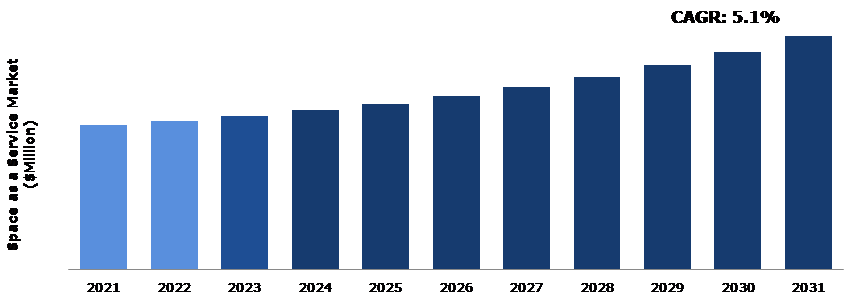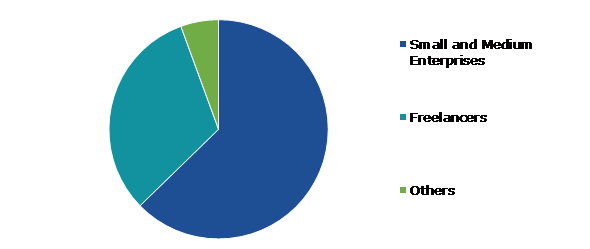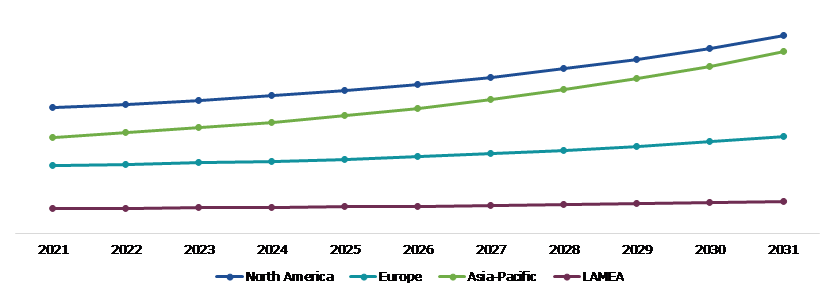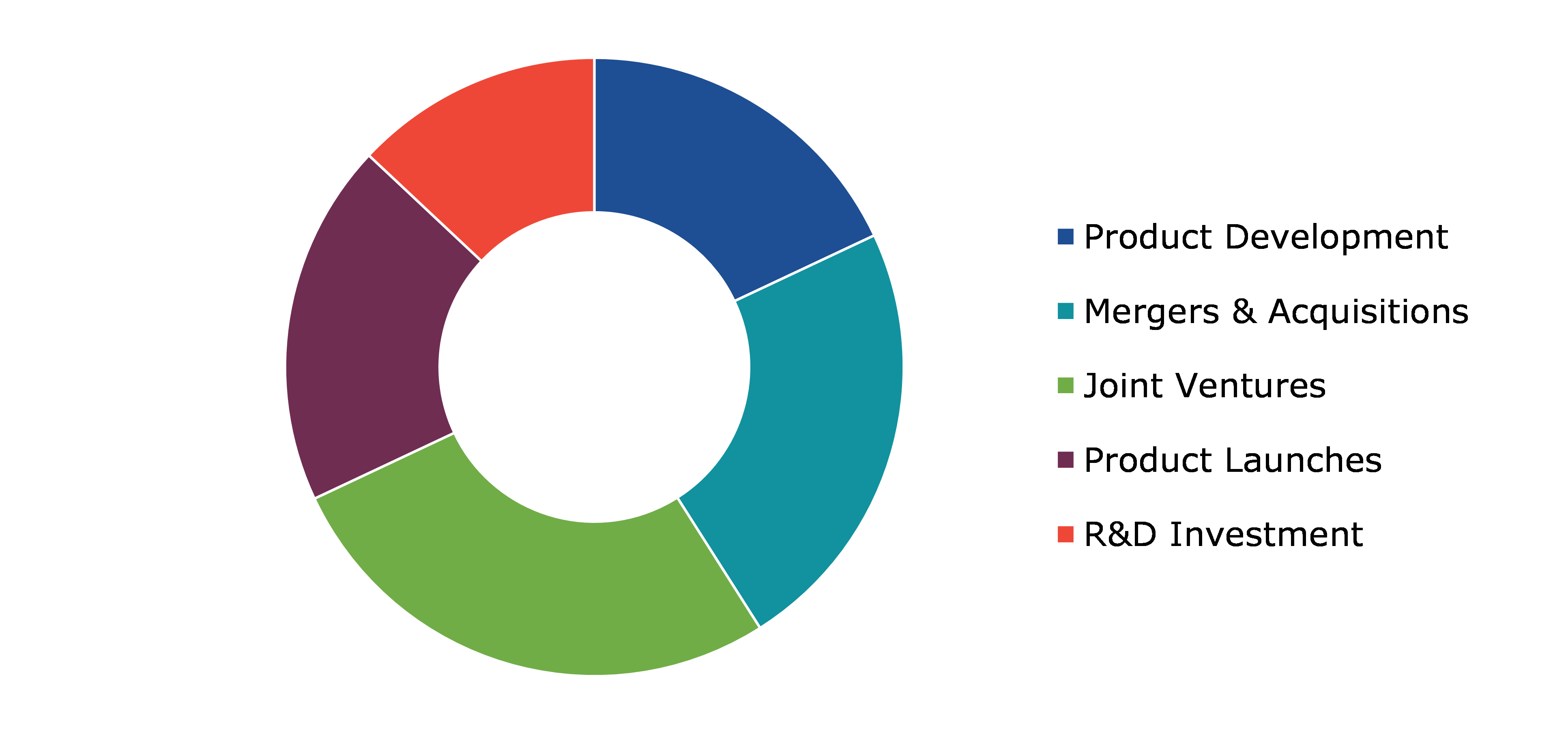Space As A Service Market Report
RA08561
Space as a Service Market by End-user (Small & Medium Enterprises, Freelancers, and Others) and Regional Analysis (North America, Europe, Asia-Pacific, and LAMEA): Global Opportunity Analysis and Industry Forecast, 2022–2031
Global Space as a Service Market Analysis
The Global Space as a Service Market Size was $8,670.50 million in 2021 and is predicted to grow with a CAGR of 5.1%, by generating a revenue of $14,017.90 million by 2031.
Global Space as a Service Market Synopsis
The Space as a Service (SPaaS) market refers to the provision of on-demand access to workspace, meeting rooms, and other office amenities, without the need for long-term leasing or ownership of office space. The factor driving this market is the growing demand for flexible working options and the increasing number of freelancers, entrepreneurs, and small businesses that require affordable, flexible office solutions. Moreover, traditional office leasing can be expensive and inflexible, requiring long-term commitments and large upfront costs. SPaaS provides a cost-effective solution that enables businesses to access the office space they need on a flexible basis. In addition, large corporations are also adopting SPaaS solutions as a way to reduce costs and increase flexibility. SPaaS providers are able to offer a range of options that meet the needs of large companies, including flexible office spaces, meeting rooms, and virtual office solutions. The SPaaS market is being driven by a combination of changing workforce dynamics, technological advancements, and a growing demand for flexible and cost-effective office solutions. These factors are anticipated to boost the space as a Service industry growth in the upcoming years.
However, some of the disadvantages of space as a service include regulatory issues. The SPaaS market is subject to various regulatory issues, including zoning laws, building codes, and health and safety regulations. These regulations can vary depending on location and can impact the ability of providers to offer their services. These regulatory issues can be particularly challenging for space-as-a-service providers who operate in multiple locations, as regulations can vary significantly from one jurisdiction to another. Regulatory issues are an important consideration for anyone looking to enter the space-as-a-service market, and it is important to work closely with legal and regulatory experts to ensure compliance with all relevant laws and regulations.
For business owners and investors hoping to profit from the rising demand for flexible office and workplace solutions, the SPaaS sector offers huge opportunities. SPaaS leading players offer a wide range of services that include meeting rooms, completely furnished workspaces, virtual office solutions, and event spaces that can be rented on a flexible, pay-per-use basis. The SPaaS market is anticipated to grow rapidly in the upcoming years, offering an exciting opportunity for innovative entrepreneurs and investors looking to disrupt the traditional office space rental market.
According to regional analysis, the North America space as a service market accounted for the largest market share in 2021 owing to the rising demand for flexible and affordable office solutions. The rise of remote work and the need for hybrid work models further boost the demand for SPaaS in North America.
Space as a Service Overview
Space as a Service (SPaaS) is a business model that provides flexible workspace solutions to individuals and organizations on a subscription or pay-per-use basis. This concept is similar to Software as a Service (SaaS), where software applications are offered on a subscription basis instead of being purchased outright. SPaaS providers offer a range of workspace options, including coworking spaces, private offices, meeting rooms, and event spaces. These spaces are fully furnished and equipped with modern amenities such as high-speed internet, printers, and video conferencing equipment.
COVID-19 Impact on Global Space as a Service Market
The COVID-19 pandemic has had a moderate impact on the SPaaS market. During the pandemic, the demand for office and workspace solutions decreased significantly, as many businesses shifted to remote work arrangements to comply with social distancing guidelines and reduce the spread of the virus. This resulted in a decline in occupancy rates and rental revenues for SPaaS providers. However, the pandemic also created new opportunities for SPaaS providers to innovate and adapt to the changing needs of their customers. Many providers introduced new health and safety measures, such as increased cleaning and disinfection, to make their workspaces safer for those who use them. Additionally, some providers shifted their focus towards providing remote work solutions, such as virtual offices and coworking spaces that can be accessed from anywhere. Some SPaaS providers have also adapted to the pandemic by implementing safety measures such as increased sanitation, social distancing protocols, and flexible cancellation policies. They focused on offering more private office spaces, as opposed to shared coworking spaces, to meet the changing demands of the market. Hence, the pandemic caused some disruptions in the SPaaS market. However, it also presented new opportunities for innovation and growth in the long term.
Growing Demand for Flexible Workspaces Sector to Drive the Market Growth
Increasing demand for flexible workspaces is primarily due to the growing trend of the gig economy and remote work. With more people opting for freelance work or working remotely, there is an increasing need for flexible workspaces that can accommodate their changing needs. SPaaS providers offer a range of flexible options such as hot-desking, private offices, and meeting rooms, which can be customized to suit the needs of individual users. These workspaces can be rented on a short-term or long-term basis, allowing users to adjust their space requirements based on their changing needs. Furthermore, SPaaS providers also offer a range of amenities and services such as high-speed internet, printing facilities, and concierge services, which make it easier for users to work efficiently and productively. The increasing demand for flexible workspaces has led to a growth in the SPaaS market, and providers are constantly innovating to provide even more customized solutions to meet the needs of their users.
To know more about global space as a service market driver, get in touch with our analysts here.
Lack of Customization and Limited Availability to Restrain the Market Growth
The limited availability of suitable properties for conversion into flexible workspaces is a potential restraint for the Space as a Service market. As demand for flexible workspace continues to grow, there may be increased competition for available properties, leading to higher prices and reduced options for providers and customers. A potential restraint of the space-as-a-service market is the lack of customization options available for businesses. While these flexible workspaces offer a range of amenities and services, they may not be able to cater to the unique needs and preferences of individual businesses. This limitation can affect various aspects of the workspace, including layout, design, and functionality, which can ultimately impact the productivity and efficiency of a business, which is anticipated to hamper the space as a service market growth.
Growing Demand from Small and Medium Enterprises (SMEs) to Offer Excellent Opportunities
The need for SPaaS from SMEs is anticipated to continue to increase during the forecast period. SMEs are increasingly realizing the advantages of flexible office spaces that let them quickly scale their business up or down as required, without incurring high costs and long-term commitments associated with traditional office leases. Moreover, SPaaS providers offer additional services and amenities including IT support and reception services, that can assist SMEs to operate more efficiently and cost-effectively. Many SMEs are looking for alternative solutions to support their distributed workforce because of the COVID-19 pandemic. SPaaS can help SMEs by providing fully equipped office spaces and meeting rooms that are available on a short-term basis and can be booked as needed.
To know more about global space as a service market opportunity, get in touch with our analysts here.
Global Space as a Service Market, by End-user
Based on end-user, the market has been divided into small & medium enterprises, freelancers, and others. Among these, the small & medium enterprises sub-segment accounted for the highest market share in 2021 and this sub-segment is estimated to show the fastest growth during the forecast period.
Global Space as a Service Market Share, by End-user, 2021
Source: Research Dive Analysis
The small & medium enterprises sub-segment accounted for the largest market share in 2021. Small and medium enterprises (SMEs) are considered as the backbone of many economies worldwide, and the SPaaS market is not an exception. SMEs require flexible, cost-effective, and scalable workspace solutions to run their businesses. SPaaS providers offer a range of workspace solutions, including co-working spaces, private offices, meeting rooms, and virtual offices, which are specifically designed to meet the needs of SMEs. These solutions provide SMEs with access to high-quality office space without having to invest in expensive real estate, office infrastructure, or long-term lease agreements. These factors are anticipated to boost the growth of small & medium enterprises sub-segment during the analysis timeframe.
Global Space as a Service Market, Regional Insights
The space as a service market was investigated across North America, Europe, Asia-Pacific, and LAMEA.
Global Space as a Service Market Size & Forecast, by region, 2021-2031 (USD Million)
Source: Research Dive Analysis
The Market for SPaaS in North America was the Most Dominant in 2021
The SPaaS market in North America is being driven by several key factors. The rise of remote work has led to an increased demand for flexible and adaptable workspace solutions. In addition, technological advancements have facilitated SPaaS providers to offer a range of amenities and services, such as high-speed internet, meeting rooms, and reception services, which attracted businesses of all sizes. The growing focus on sustainability and energy efficiency in this region is expected to increase the demand for SPaaS solutions providers that offer environmentally friendly buildings and spaces.
Competitive Scenario in the Global Space as a Service Market
Investment and agreement are common strategies followed by major market players. For instance, in November 2021, Awfis, an Indian company using the space as a service business model, collaborated with the American real estate service company CBRE and the startup agritech company WayCool. For the three parties engaged in the transaction, this cooperation has created a number of new business opportunities because they can each strengthen their position in their respective industries by combining their own skills.
Source: Research Dive Analysis
Some of the leading space as a service market players are WeWork, 91springboard, Awfis, Common Ground, Innov8, Workbar LLC, Regus, Colive, MindSpace, and Industrious.
| Aspect | Particulars |
| Historical Market Estimations | 2019-2020 |
| Base Year for Market Estimation | 2021 |
| Forecast Timeline for Market Projection | 2022-2031 |
| Geographical Scope | North America, Europe, Asia-Pacific, LAMEA |
| Segmentation by End-use |
|
| Key Companies Profiled |
|
Q1. What is the size of the global space as a service market?
A. The size of the global space as a service market was over $8,670.50 million in 2021 and is projected to reach $14,017.90 million by 2031.
Q2. Which are the major companies in the space as a service market?
A. WeWork, 91springboard, and Awfis are some of the key players in the global space as a service market.
Q3. Which region, among others, possesses greater investment opportunities in the near future?
A. The Asia-Pacific region possesses great investment opportunities for investors to witness the most promising growth in the future.
Q4. What will be the growth rate of the Asia-Pacific space as a service market?
A. Asia-Pacific space as a service market is anticipated to grow at 6.8% CAGR during the forecast period.
Q5. What are the strategies opted by the leading players in this market?
A. Agreement and investment are the two key strategies opted by the operating companies in this market.
Q6. Which companies are investing more on R&D practices?
A. Common Ground, Innov8, and Workbar LLC. are the companies investing more on R&D activities for developing new products and technologies.
1.Research Methodology
1.1.Desk Research
1.2.Real time insights and validation
1.3.Forecast model
1.4.Assumptions and forecast parameters
1.5.Market size estimation
1.5.1.Top-down approach
1.5.2.Bottom-up approach
2.Report Scope
2.1.Market definition
2.2.Key objectives of the study
2.3.Report overview
2.4.Market segmentation
2.5.Overview of the impact of COVID-19 on Global space as a service market
3.Executive Summary
4.Market Overview
4.1.Introduction
4.2.Growth impact forces
4.2.1.Drivers
4.2.2.Restraints
4.2.3.Opportunities
4.3.Market value chain analysis
4.3.1.List of raw material suppliers
4.3.2.List of manufacturers
4.3.3.List of distributors
4.4.Innovation & sustainability matrices
4.4.1.Technology matrix
4.4.2.Regulatory matrix
4.5.Porter’s five forces analysis
4.5.1.Bargaining power of suppliers
4.5.2.Bargaining power of consumers
4.5.3.Threat of substitutes
4.5.4.Threat of new entrants
4.5.5.Competitive rivalry intensity
4.6.PESTLE analysis
4.6.1.Political
4.6.2.Economical
4.6.3.Social
4.6.4.Technological
4.6.5.Environmental
4.7.Impact of COVID-19 on space as a service market
4.7.1.Pre-covid market scenario
4.7.2.Post-covid market scenario
5.Space as a Service Market Analysis, by End-user
5.1.Small & Medium Enterprises
5.1.1.Definition, key trends, growth factors, and opportunities
5.1.2.Market size analysis, by region,2021-2031
5.1.3.Market share analysis, by country,2021-2031
5.2.Freelancers
5.2.1.Definition, key trends, growth factors, and opportunities
5.2.2.Market size analysis, by region,2021-2031
5.2.3.Market share analysis, by country,2021-2031
5.3.Others
5.3.1.Definition, key trends, growth factors, and opportunities
5.3.2.Market size analysis, by region,2021-2031
5.3.3.Market share analysis, by country,2021-2031
5.4.Research Dive Exclusive Insights
5.4.1.Market attractiveness
5.4.2.Competition heatmap
6.Space as a Service Market, by region
6.1.North America
6.1.1.U.S.
6.1.1.1.Market size analysis, by End-user,2021-2031
6.1.2.Canada
6.1.2.1.Market size analysis, by End-user,2021-2031
6.1.3.Mexico
6.1.3.1.Market size analysis, by End-user,2021-2031
6.1.4.Research Dive Exclusive Insights
6.1.4.1.Market attractiveness
6.1.4.2.Competition heatmap
6.2.Europe
6.2.1.Germany
6.2.1.1.Market size analysis, by End-user,2021-2031
6.2.2.UK
6.2.2.1.Market size analysis, by End-user,2021-2031
6.2.3.France
6.2.3.1.Market size analysis, by End-user,2021-2031
6.2.4.Spain
6.2.4.1.Market size analysis, by End-user,2021-2031
6.2.5.Italy
6.2.5.1.Market size analysis, by End-user,2021-2031
6.2.6.Rest of Europe
6.2.6.1.Market size analysis, by End-user,2021-2031
6.2.7.Research Dive Exclusive Insights
6.2.7.1.Market attractiveness
6.2.7.2.Competition heatmap
6.3.Asia Pacific
6.3.1.China
6.3.1.1.Market size analysis, by End-user,2021-2031
6.3.2.Japan
6.3.2.1.Market size analysis, by End-user,2021-2031
6.3.3.India
6.3.3.1.Market size analysis, by End-user,2021-2031
6.3.4.Australia
6.3.4.1.Market size analysis, by End-user,2021-2031
6.3.5.South Korea
6.3.5.1.Market size analysis, by End-user,2021-2031
6.3.6.Rest of Asia Pacific
6.3.6.1.Market size analysis, by End-user,2021-2031
6.3.7.Research Dive Exclusive Insights
6.3.7.1.Market attractiveness
6.3.7.2.Competition heatmap
6.4.LAMEA
6.4.1.Brazil
6.4.1.1.Market size analysis, by End-user,2021-2031
6.4.2.Saudi Arabia
6.4.2.1.Market size analysis, by End-user,2021-2031
6.4.3.UAE
6.4.3.1.Market size analysis, by End-user,2021-2031
6.4.4.South Africa
6.4.4.1.Market size analysis, by End-user,2021-2031
6.4.5.Rest of LAMEA
6.4.5.1.Market size analysis, by End-user,2021-2031
6.4.6.Research Dive Exclusive Insights
6.4.6.1.Market attractiveness
6.4.6.2.Competition heatmap
7.Competitive Landscape
7.1.Top winning strategies, 2021
7.1.1.By strategy
7.1.2.By year
7.2.Strategic overview
7.3.Market share analysis, 2021
8.Company Profiles
8.1.WeWork
8.1.1.Overview
8.1.2.Business segments
8.1.3.Product portfolio
8.1.4.Financial performance
8.1.5.Recent developments
8.1.6.SWOT analysis
8.2.91springboard
8.2.1.Overview
8.2.2.Business segments
8.2.3.Product portfolio
8.2.4.Financial performance
8.2.5.Recent developments
8.2.6.SWOT analysis
8.3.Awfis
8.3.1.Overview
8.3.2.Business segments
8.3.3.Product portfolio
8.3.4.Financial performance
8.3.5.Recent developments
8.3.6.SWOT analysis
8.4.Common Ground
8.4.1.Overview
8.4.2.Business segments
8.4.3.Product portfolio
8.4.4.Financial performance
8.4.5.Recent developments
8.4.6.SWOT analysis
8.5.Innov8
8.5.1.Overview
8.5.2.Business segments
8.5.3.Product portfolio
8.5.4.Financial performance
8.5.5.Recent developments
8.5.6.SWOT analysis
8.6.Workbar LLC
8.6.1.Overview
8.6.2.Business segments
8.6.3.Product portfolio
8.6.4.Financial performance
8.6.5.Recent developments
8.6.6.SWOT analysis
8.7.Regus
8.7.1.Overview
8.7.2.Business segments
8.7.3.Product portfolio
8.7.4.Financial performance
8.7.5.Recent developments
8.7.6.SWOT analysis
8.8.Colive
8.8.1.Overview
8.8.2.Business segments
8.8.3.Product portfolio
8.8.4.Financial performance
8.8.5.Recent developments
8.8.6.SWOT analysis
8.9.MindSpace
8.9.1.Overview
8.9.2.Business segments
8.9.3.Product portfolio
8.9.4.Financial performance
8.9.5.Recent developments
8.9.6.SWOT analysis
8.10.Industrious
8.10.1.Overview
8.10.2.Business segments
8.10.3.Product portfolio
8.10.4.Financial performance
8.10.5.Recent developments
8.10.6.SWOT analysis
Space-as-a-service refers to provisioning of space i.e., real estate for office spaces in the form of a service. Thus, space-as-a-service changes the characteristic of real estate from asset ownership model to a service. This is different from buying real estate or renting an office space as space-as-a-service entails paying for the real estate only when the user wants to make use of the space for a limited timeframe or temporary basis. Space-as-a-service has become extremely popular in contemporary corporate culture as it saves the company from investing in real estate.
Forecast Analysis of the Space as a Service Market
In recent years, there has been an increase in the demand for flexible workspaces which is expected to be the primary growth driver of the global space as a service market in the forecast years. Along with this, a surge in the demand for space-as-a-service from small and medium enterprises is expected to push the market further. Also, changing workforce dynamics, technological advancements, and a growing demand for cost-effective office solutions is predicted to offer numerous investment and growth opportunities to the market in the analysis timeframe. However, lack of customization and limited availability may restrain the growth of the space as a service market in the forecast period.
Regionally, the space as a service market in the North America region is expected to be the most dominant by 2031. Surging demand for flexible and adaptable workspace solutions across the whole region is anticipated to become the main growth driver of the market in the forecast period.
According to the report published by Research Dive, the global space as a service market is expected to gather a revenue of $14,017.90 million by 2031 and grow at 5.1% CAGR in the 2022-2031 timeframe. Some prominent market players include WeWork, Innov8, Colive, 91springboard, Workbar LLC, MindSpace, Awfis, Regus, Industrious, Common Ground, and many others.
Covid-19 Impact on the Market
The outbreak of the Covid-19 pandemic has had a massive negative effect on almost all industries and businesses across the world. The space as a service market faced a moderate impact of the pandemic. As most offices were shut down due to the pandemic, there was an overall reduction in the demand for space as a service model. At the same time, however, the pandemic offered numerous opportunities for the space-as-a-service industry to adapt to the changing office and work environment.
Space as a Service Market Developments
The significant companies operating in the industry are adopting numerous growth strategies & business tactics such as partnerships, collaborations, mergers & acquisitions, and launches to maintain a robust position in the overall market, thus helping the space as a service market to flourish. For instance:
- In February 2020, biproxi, a commercial real estate platform developer, announced the acquisition of OfficeSpace.com, a workplace management software developer. This acquisition is anticipated to help biproxi to cater to the demands of various corporate entities in a much holistic way.
- In January 2022, WeWork, a workspace solutions provider, announced the acquisition of Common Desk, a coworking and office space rentals company. This acquisition is predicted to expand the market share of WeWork tremendously in the coming period.
- In June 2022, Space Matrix, a Singapore-based office design firm, announced the acquisition of Pursuite, a leading e-commerce platform. This acquisition, as per Space Matrix, is being done to address the growing demands for flexible workspaces and the acquisition will help the company to expand its operations globally in the coming period.
Personalize this research
- Triangulate with your own data
- Request your format and definition
- Get a deeper dive on a specific application, geography, customer or competitor
- + 1-888-961-4454 Toll - Free
- support@researchdive.com





